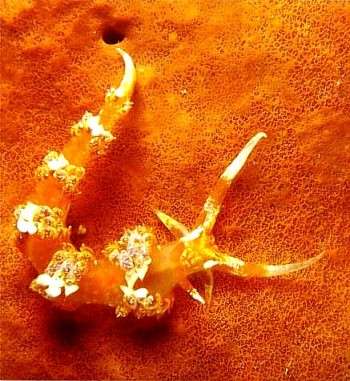
Austraeolis catina
Marcus & Marcus, 1967
Order: NUDIBRANCHIA
Suborder: AEOLIDINA
Family: Glaucidae
DISTRIBUTION
Caribbean
PHOTO
Belize [western Caribbean], July 1999, Length 0.5 - 1 inch. PHOTO: Anne Dupont.
Known from Florida and Jamaica (Marcus & Marcus, 1967), and Belize (see message below). Original description described body as 'transparent greyish .. with brown marks on side of head and middle of rhinophores' and with white speckling on skin, concentrated in some parts such as middle of head, tentacles etc.
One feature not clearly seen in the photos are the rhinophores which are described as having up to 12 rings.
Reference:
• Marcus, E. & Marcus, E. (1967). Tropical American Opisthobranchs. Studies in Tropical Oceanography Miami, 6: 1-137.
Related messages
Re: Austraeolis catina from St Kitts, Caribbean Se
March 26, 2010
From: Eric Kaye

Concerning message #23387:
Bill,
Here are pics of two others I found in Saba the same week. One is on a purple tube sponge, and the other on yet a different sponge. It may be safe to conclude that it probably doesn't eat the orange sponge.
Locality: Reef, 30 feet, Saba, Caribbean Sea, 18 March 2010, On a sponge. Length: 3mm. Photographer: Eric Kaye.
Eric Kaye
ek@erickaye.com
Kaye, Eric, 2010 (Mar 26) Re: Austraeolis catina from St Kitts, Caribbean Se. [Message in] Sea Slug Forum. Australian Museum, Sydney. Available from http://www.seaslugforum.net/find/23396
Dear Eric,
Thanks for that. All we need now is for someone actually finding it feeding on a hydroid.
Best wishes,
Bill Rudman
Austraeolis catina from St Kitts, Caribbean Sea
March 24, 2010
From: Eric Kaye
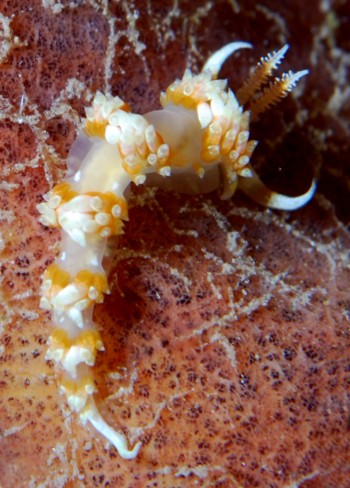
Managed to get a decent shot of this Austraeolis catina in St Kitts this week. Actually saw 4 of them during the week in various locations in St. Kitts and Saba.
Locality: St Kitts, 40 feet, St. Kitts, Caribbean Sea, 15 March 2010, On a sponge. Length: 2-3 cm. Photographer: Eric Kaye.
Eric Kaye
ek@erickaye.com
Kaye, Eric, 2010 (Mar 24) Austraeolis catina from St Kitts, Caribbean Sea. [Message in] Sea Slug Forum. Australian Museum, Sydney. Available from http://www.seaslugforum.net/find/23387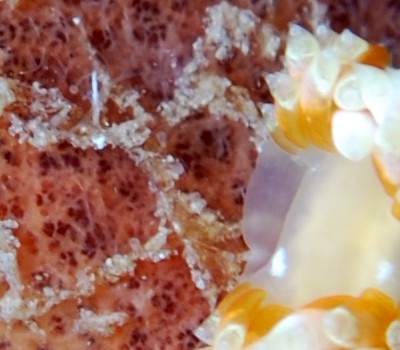
Dear Eric,
Thanks for the excellent photos which shows the shape of the rhinophores very well. As I mentioned in an earlier message [#19814], in almost all the photos I have seen of this species it is on the same species of sponge. If it belonged to a family of nudibranchs that ate sponges I would be pretty convinced we had found its choice of food. However, with few exceptions, species of aeolids feed on cnidarians, including sea anemones and hydroids. I would expect this species to feed on one or more species of hydroids, and in your photo there is a network running over the sponge colony - it looks whitish, because whitish particles seem to have become stuck to whatever is forming the network. In the close-up alongside, I am pretty sure I can see the skeletons of small stalked hydroids which may well be this species' food.
Best wishes,
Bill Rudman
Austraeolis catina and its sponge
April 16, 2007
From: Bill Rudman
Concerning message #19779:
Dear Marianne and Dave,
When I was reading Dave's comments on Marianne's Austraeolis catina, I was struck again by the fact that this slug seems to be always on the same or a very similar looking sponge in all the photos we have of it on the Forum. And it also seems to be on it in Marianne's message and in the photo in Caribbean Sea Slugs. As I commented in an earlier message [#14798], it seems this species may feed on a hydroid with an obligate association with this sponge. It would be a nice little project for a studnet to investigate
Best wishes
Bill Rudman
Austraeolis catina from Bonaire, Caribbean Sea
April 16, 2007
From: Marianne Ligthart

Dear Bill.
We found this nudibranch during a nightdive. Dive site:'Front Porch'/Bonaire:(s-w.coast near Kralendijk)/Caribbean Sea.
Length:15 mm. Food: possibly hydroids (there where lots of them)Depth: 7-8 m. We saw several animals of the same kind.
Locality: Front Porch, near Kralendijk, Bonaire., 7 - 8 metres, Bonaire, Caribbean Sea, 24 February 2007, Ot sponges, maybe overgrown with hydroids. Length: 15 mm. Photographer: Marco Faasse.
We are not sure about the identification. Flabellina hamanni seems possible to us but some details are not visible (the purple ring on the cerata)
Greetings,
Marianne Ligthart
mligthart01@freeler.nl
Ligthart, A., 2007 (Apr 16) Austraeolis catina from Bonaire, Caribbean Sea. [Message in] Sea Slug Forum. Australian Museum, Sydney. Available from http://www.seaslugforum.net/find/19779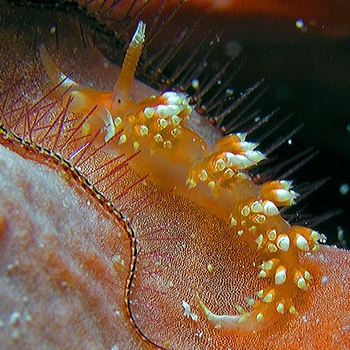
Dear Marianne,
Caribbean aeolids can be a challenge to ID. The species you present here is Austraeolis catina Marcus & Marcus, 1967. You will find photos nearly identical to yours in Caribbean Sea Slugs on page 248.
Your observations here provide a new southerly point in the species distribution.
-
Valdes, A., J. Hamann, D.W. Behrens & A. DuPont. 2006. Caribbean Sea Slugs - A field guide to the opisthobranch mollusks from tropical northwestern Atlantic. Sea Challengers, Gig Harbor, Washington. 289p.
Thanks for sharing this,
Dave Behrens
Reference:
Behrens, D.W., 2007 (Apr 16). Comment on Austraeolis catina from Bonaire, Caribbean Sea by Marianne Ligthart. [Message in] Sea Slug Forum. Australian Museum, Sydney. Available from http://www.seaslugforum.net/find/19779
Austraeolis catina and its food? sponge
September 20, 2005
From: Linda Ianniello

Dr. Bill,
I found three Austraeolis catina last night. They were all on the sponge shown in the enclosed shot, which I believe is their food sponge. I also included a close-up of one of the slugs.
Locality: The Gazebo, Boynton Beach, Florida, USA. Depth: 60 ft. 17 September 2005. Reef. Photographer: Linda Ianniello
Linda Ianniello
lindai1@bellsouth.net
Ianniello, L.M., 2005 (Sep 20) Austraeolis catina and its food? sponge. [Message in] Sea Slug Forum. Australian Museum, Sydney. Available from http://www.seaslugforum.net/find/14798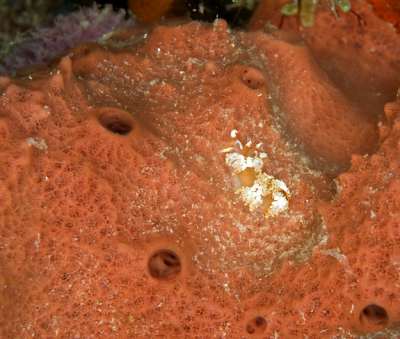
Dear Linda,
Thanks for these interesting photos - and for raising the possibility that this animal feeds on a sponge. Although all things are possible, I don't think any aeolid has been observed feeding on sponges. I agree that most of the other records we have of thios species show it on this very sponge suggesting a close association between the sponge and the aeolid. However I think this is probably the same sort of association species of Trapania have with particular sponges - they don't feed on the sponges, but they feed on an animal which lives in close association with the sponge.
I suspect A. catina may be feeding on a hydroid which lives in close association with this sponge. I have just added some illustrations to Fact Sheet of Cuthona kuiteri, because that remarkable species, as well as having cerata which mimic the hydroid polyp it feeds on, also live in close association with a sponge, but feed on an hydroid, Zyzzyzus spongicola, which is a solitary tubularian living partially buried in sponge colonies. It would be interesting if next time you saw this aeolid on the sponge, you had a close look for small hydroid polyps. I am sure that is not the easiest request, because the polyps are likely to be small, and are likely to retract if startled, either by unusual water movement or even by shadows passing over them.
When you see the aeolid on the sponge it is remarkably well camouflaged. The translucent orange breaks up the body shape leaving the white bits to look like bits of white coral sand.
Best wishes,
Bill Rudman
Re: Bahama slugs
February 15, 2001
From: Marli Wakeling
Thanks for your message Anne. I checked another photo of this critter taken on the island of Saba, and it appears to be the same critter, with a little more intense colouration.
Marli
scubamarli@excite.com
Wakeling, M., 2001 (Feb 15) Re: Bahama slugs. [Message in] Sea Slug Forum. Australian Museum, Sydney. Available from http://www.seaslugforum.net/find/3806Re: Bahama slugs
February 14, 2001
From: Anne DuPont

Dear Marli,
I saw your posting on the Sea Slug Forum, 'Bahama slugs'. Take a look at the Austraeolis catina page. It looks very like your undescribed Facelina. I have photographed this nudibranch in Florida, and the Caribbean and it looks like the same critter in your photo. My photos on the Forum were taken in Belize and I'm posting one here taken in Florida. Is this your critter?
Cheers,
Anne DuPont
adupont@gate.net
Du Pont, A., 2001 (Feb 14) Re: Bahama slugs. [Message in] Sea Slug Forum. Australian Museum, Sydney. Available from http://www.seaslugforum.net/find/3740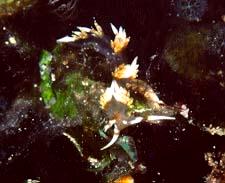
Dear Anne,
Thanks for the suggested identification. I have included a copy of Marli's photo alongside for comparison. The general shape is very similar, to 'Austraeolis' catina but most phidianids have this general body shape with clusters of cerata. Unless Marli has a photo in which we can see the colour clearly, and the shape of the rhinophores, it won't be possible to definitely identify Marli's animal.
But within the limitations of the photo I think Austraeolis catina is probably the best answer.
Best wishes,
Bill Rudman
Re: The 'Long-Horn' aeolid from Belize
August 26, 1999
From: Sandra Millen
The long horn aeolid from Belize is Austraeolis catina Marcus & Marcus, 1967. The reference is in Tropical American Opisthobranchs. Studies in Tropical Oceanography Miami 6: 1-137.
Jeff Hamann is compiling photographs for a book on Caribbean Opisthobranchs. He has taken many fine photographs and found several undescribed species. We are currently working on a paper describing three new species of Flabellina from the Caribbean.
Sandra Millen
millen@zoology.ubc.ca
Millen, S., 1999 (Aug 26) Re: The 'Long-Horn' aeolid from Belize. [Message in] Sea Slug Forum. Australian Museum, Sydney. Available from http://www.seaslugforum.net/find/1247Thanks Sandra,
I look forward to the book, and your joint paper.
Bill Rudman.
The 'Long-Horn' aeolid from Belize
August 25, 1999
From: Anne DuPont

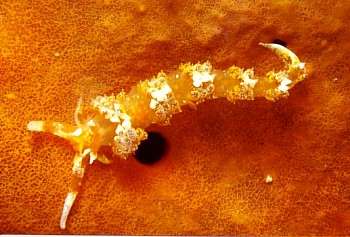
The Long-Horn Nudibranchs are another species I photographed in Belize [western Caribbean] last month. They were 1/2 to 1 inch long! We have them in Florida but they are about 1/4 inch long here.
Regards,
Anne
adupont@gate.net
DuPont, A., 1999 (Aug 25) The 'Long-Horn' aeolid from Belize. [Message in] Sea Slug Forum. Australian Museum, Sydney. Available from http://www.seaslugforum.net/find/1240Dear Anne,
As with the last photos you sent me I don't know this species either, and I don't have Paul Humann's book. It looks like a species of Phidiana or something similar. Since we had instant success with your last photo, I'm sure we won't have to wait long for some more information on this one.
It certainly illustrates how poor the literature on the West Atlantic fauna is. As far as the Caribbean fauna is concerned the greater part of the scientific literature consists of Marcus's papers describing preserved animals. Apart from the recent message from Phanor Montoya in Colombia, I have had a number of messages from students in Latin America who would like to study nudibranchs and find it impossible to identify even the most common species. Are there any good books I don't know about? If not, I am happy to post photos of West Atlantic species. Obviously I would need help with photos and some background information.
Bill Rudman.
